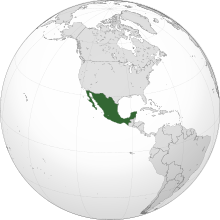Nymphaea gracilis is a species of waterlily endemic to Mexico.[1] It is the only species of its genus which is endemic to Mexico.[2]
| Nymphaea gracilis | |
|---|---|

| |
| Nymphaea gracilis as Nymphaea flavovirens | |
| Scientific classification | |
| Kingdom: | Plantae |
| Clade: | Tracheophytes |
| Clade: | Angiosperms |
| Order: | Nymphaeales |
| Family: | Nymphaeaceae |
| Genus: | Nymphaea |
| Subgenus: | Nymphaea subg. Brachyceras |
| Species: | N. gracilis
|
| Binomial name | |
| Nymphaea gracilis Zucc.[1]
| |

| |
| Nymphaea gracilis is endemic to Mexico[1] | |
| Synonyms[1] | |
| |
Description
editVegetative characteristics
editNymphaea gracilis has very short, subglobose rhizomes densely covered with fibrous roots. The petiolate, glabrous, orbicular floating leaves[3] with dentate margins are 35–40 cm long, and 28–35 cm wide.[4] The adaxial leaf surface is bright green, and the abaxial leaf surface is suffused with purple colouration.[3] The terete, 1.2 cm wide petiole is 60–150 cm long.[5]
Generative characteristics
editThe flowers are 8–10 cm wide,[4] and extend up to 20–40 cm above the water surface. They have four lanceolate, green sepals and 18-20 white sepals. The androecium consists of 60 stamens.[2] The gynoecium consists of 12-15 carpels.[5] The globose 2–3.5 cm wide fruit bears arillate seeds with a reticulate testa, and trichomes.[2] The flowers are fragrant.[2]
Cytology
editGenerative reproduction
editNymphaea gracilis is facultatively xenogamous.[6]
Taxonomy
editPublication
editIt was first described by Joseph Gerhard Zuccarini in 1832.[1][7]
Placement within Nymphaea
editIt is placed in Nymphaea subgenus Brachyceras.[8]
Etymology
editThe specific epithet gracilis means thin, slender or graceful.[9][10][11]
Conservation
editEcology
editHabitat
editIt grows in canals,[14] swamps, shallow ponds,dams, and lakes.[12]
Pollination
editThe flowers attract flies and bees. The bee species Apis mellifera is the most important pollinator of Nymphaea gracilis, followed by the fly species Allograpta obliqua, and Asemosyrphus sp.[6]
Use
editCultivation
editIt has been used in artificial hybridisation to create new waterlily cultivars.[15]
References
edit- ^ a b c d e "Nymphaea gracilis Zucc". Plants of the World Online. Royal Botanic Gardens, Kew. Retrieved 30 December 2023.
- ^ a b c d e f Sandoval-Ortega, M. H. (2020). "Contribución al conocimiento de Nymphaea gracilis Zucc. en Aguascalientes, México." Tecnociencia Chihuahua, 14(1), 561-561.
- ^ a b Zuccarini, J. G. (1832). Plantarum novarum vel minus cognitarum descriptio, fasc. I. Abhandlungen Der Mathematisch-Physikalischen Classe Der Königlich Bayerischen Akademie Der Wissenschaften, 1, 362–363. http://www.biodiversitylibrary.org/openurl?ctx_ver=Z39.88-2004&rft.date=1832&rft.spage=362&rft.volume=1&rft_id=http://www.biodiversitylibrary.org/bibliography/10920&rft_val_fmt=info:ofi/fmt:kev:mtx:book&url_ver=z39.88-2004
- ^ a b Henkel, F., Rehnelt, F., Dittmann, L., Dittman, L. (1907). "Das buch der Nymphaeceen oder Seerosengewächse." pp. 59-60. Deutschland: F. Henkel.
- ^ a b Conard, H. S. (2015). The Waterlilies: A Monograph of the Genus Nymphaea (Classic Reprint). pp. 137-139. USA: FB&C Limited.
- ^ a b c Zepeda-Gómez, C., Cruz-Muciño, E., Burrola-Aguilar, C., & Estrada-Zúñiga, M. E. (2020). "Floral biology, floral visitors, and reproductive system of Nymphaea gracilis Zucc.(Nymphaeaceae)." Botanical Sciences, 98(4), 499-515.
- ^ Nymphaea gracilis | International Plant Names Index. (n.d.). Retrieved December 30, 2023, from https://www.ipni.org/n/171186-2
- ^ Borsch, T., Löhne, C., & Wiersema, J. (2008). "Phylogeny and evolutionary patterns in Nymphaeales: integrating genes, genomes and morphology." Taxon, 57(4), 1052-4E.
- ^ Missouri Botanical Garden. (n.d.-b). Deutzia gracilis - Plant Finder. Retrieved January 1, 2024, from https://www.missouribotanicalgarden.org/PlantFinder/PlantFinderDetails.aspx?kempercode=v560
- ^ Drakaea gracilis Hopper & A. P. Br. (n.d.). Encyclopedia of Life. Retrieved January 1, 2024, from https://eol.org/pages/5950126/articles
- ^ Passiflora gracilis | The Italian Collection of Maurizio Vecchia. (n.d.). Passiflora. Retrieved January 1, 2024, from https://www.passiflora.it/gracilis/319/eng/
- ^ a b c Lot, A., Novelo, A. (2004). "Iconografía y estudio de plantas acuáticas de la ciudad de México y sus alrededores." pp. 128-129. Mexiko: UNAM. Instituto de Biología.
- ^ CONABIO. (n.d.). Ninfa cabeza de negro (Nymphaea gracilis). EncicloVida. Retrieved January 1, 2024, from https://enciclovida.mx/especies/166039-nymphaea-gracilis
- ^ Cordova, C. E. (2022). "The Lakes of the Basin of Mexico: Dynamics of a Lacustrine System and the Evolution of a Civilization." p. 69. Deutschland: Springer International Publishing.
- ^ Kilbane, T. (n.d.). August Walking Tour – Water Gardens. Denver Botanic Gardens. Retrieved January 1, 2024, from https://www.botanicgardens.org/blog/august-walking-tour-water-gardens-1